In this emerging world of modern design of structures, Concrete acts as the backbone of civil engineering. A structural engineer’s first and foremost objective is to build an efficient and durable concrete structure that is also aesthetically pleasing. Here comes the role of a concrete designer. When the aim is to build a concrete structure that is efficient and durable, this demands to follow the concrete mix design steps as per IS codes (IS- 10262:2009 and IS- 456:2000).
If you are searching for detailed step by step procedure for concrete mix design of M40 grade using IS – 10262:2009 and IS – 456:2000….
Then yes you are in the write place!!!
Before reading this post just go and check “Concrete mix design procedure as per IS 10262:2009 & IS 456:2000” .
This post will help you to have a brief idea of different parameters required and will also make you aware about the different experimental data required for conducting the mix design of concrete.
Concrete Mix Design
- Calculate cement, sand and aggregate quantity in concrete.
- Calculate the number of premix bags required for your project.
- Option to set your own size and rate of premix bags.
- Calculate the volume of concrete required for slabs, walls, footings and columns.
- Calculate the weight of ingredients required for preparing the calculated volume of concrete.
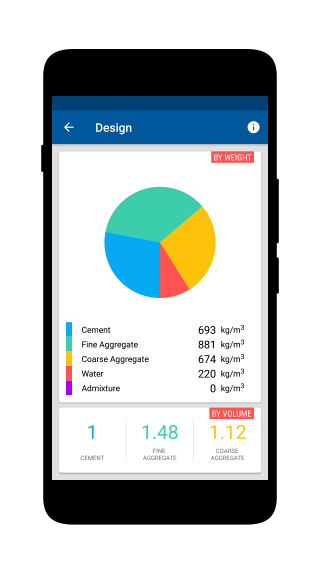
Detailed calculation for M40 Grade mix
The different design stipulations required for the desired mix are shown in the table below:
| Stipulations for proportioning | |
|---|---|
| Type of Concrete | RCC |
| Grade Designation | M40 |
| Shape of Particle | Angular |
| Slump | 110 mm |
| Water- Cement Ratio | 0.50 |
| Exposure Condition | Severe |
| Concrete Placement | Pump |
| Degree of Supervision | Good |
The different experiemental data required for the desiered mix are shown in the table below:
| Sieve analysis | |
|---|---|
| Fine Aggregate | Zone 2 |
| Coarse Aggregate | 20 mm |
| Chemical Admixture | |
|---|---|
| Volume ( By mass of cement) | 2% |
| Water Content Reduction | Zero |
| Test data for materials | |
|---|---|
| Standard Deviation | 5 MPa |
| Specific Gravity of Fine Aggregate | 2.74 |
| Specific Gravity of Coarse Aggregate | 2.74 |
| Specific Gravity of Cement | 3.15 |
| Specific Gravity of Admixture | 1.00 |
| Water absorption of Fine Aggregate | 1.0 % |
| Water absorption of Coarse Aggregate | 0.5% |
| Free Surface Moisture of Fine Aggregate | Zero |
| Free Surface Moisture of Coarse Aggregate | Zero |
Step by step detailed procedure for concrete mix design of M40 grade as per IS – 10262:2009 and IS- 456:2000
Step 1: Calculate the target mean compressive strength at 28 days
| target mean compressive strength | characteristic strength + 1.65 X Standard Deviation |
| target mean compressive strength | 40 + 1.65 X 5 = 48.25 N/mm2 |
Where sufficient test results for a particular grade of concrete are not available, the value of standard deviation could be taken from Table 1 of IS10262.
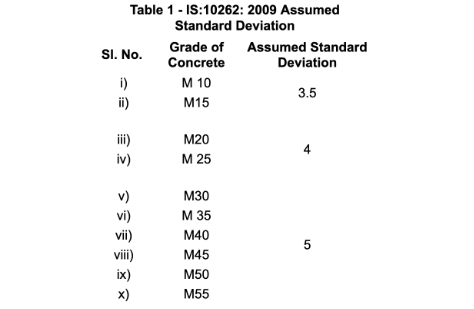
Step 2: Selection of maximum water/cement ratio
The maximum water-cement ratio should be selected as per Table 5 of IS – 456: 2000.
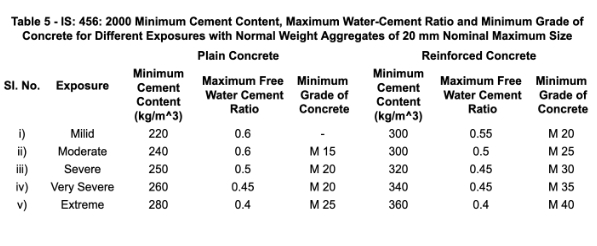
| Maximum water-cement ratio | 0.45 |
| Adopted water-cement ratio | 0.45 |
Step 3: Estimation of entrapped air
For the maximum size of aggregate used the air content is estimated.
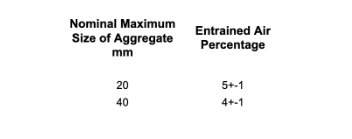
Step 4: Selection of water content and fine to total aggregate ratio
The selection of water content is based on Table 2 of IS:10262:2009.
Maximum water content for 20 mm aggregate and a slump value of 25 to 50 mm = 186.00 l.
But in our problem the value of slump is 110 mm, so we need to alter the water content.
| Estimated water content | 186 + 7/100 X 186 = 199.39 litres |
Step 5: Calculation of Cement content
The cement content per unit volume of concrete is computed sing Table 5 of IS:456:2000:
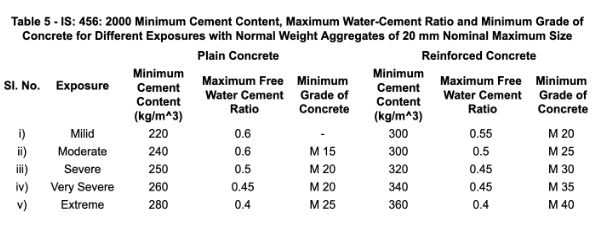
| Minimum cement content for mild expossure condition | 320 kg/ m3 |
| Maximum cement content | 450 kg/ m3 |
| cement content | 199.39/0.45 = 443.09 kg / m3 |
Check : 320 kg/ m3 < 443.09 kg / m3 < 450 kg/ m3 Hence O.K.
Step 6: Calculation of aggregate content
Volume of coarse aggregate per unit volume of total aggregate for corresponding to 20 mm maximum size and zone I of fine aggregate = 0.62 – Table 3 of IS- 10262:2009.
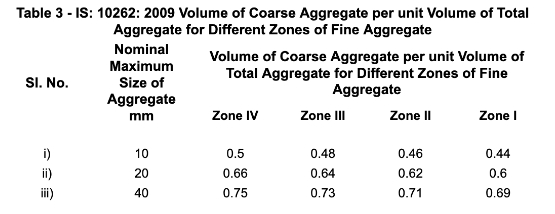
Correction:
| Based on water cement ratio | 0.01 |
| Based on placement | 10.00 |
Hence Volume
| Coarse aggregate | 0.57 |
| Fine aggregate | 0.43 |
$$
V=\left[W+\left(C / S_{c}\right)+(1 / P) \cdot\left(f_{a} / S_{f a}\right)\right] \times(1 / 1000)
$$
$$
C_{a}=1- P / P \times f_{a} \times S_{ca}/ S_{fa}
$$
| Mass of Coarse aggregate | 1025.27 kg / m3 |
| Mass of Fine aggregate | 782.97 kg / m3 |
Step 7: Computation of actual quantities required for a concrete mix – Trial mix
Water Correction
Extra quantity of water to be added
| Coarse aggregate | 5.13 kg |
| Fine aggregate | 7.83 kg |
| Mix Design | |
| Cement | 443 kg / m3 |
| Water | 212 kg / m3 |
| Fine Aggregate | 775 kg / m3 |
| Coarse Aggregate | 1020 kg / m3 |

Concrete Mix Design
Take some time to enter the input data as per your problem and get the Complete mix design results in few seconds….
Mix design Result
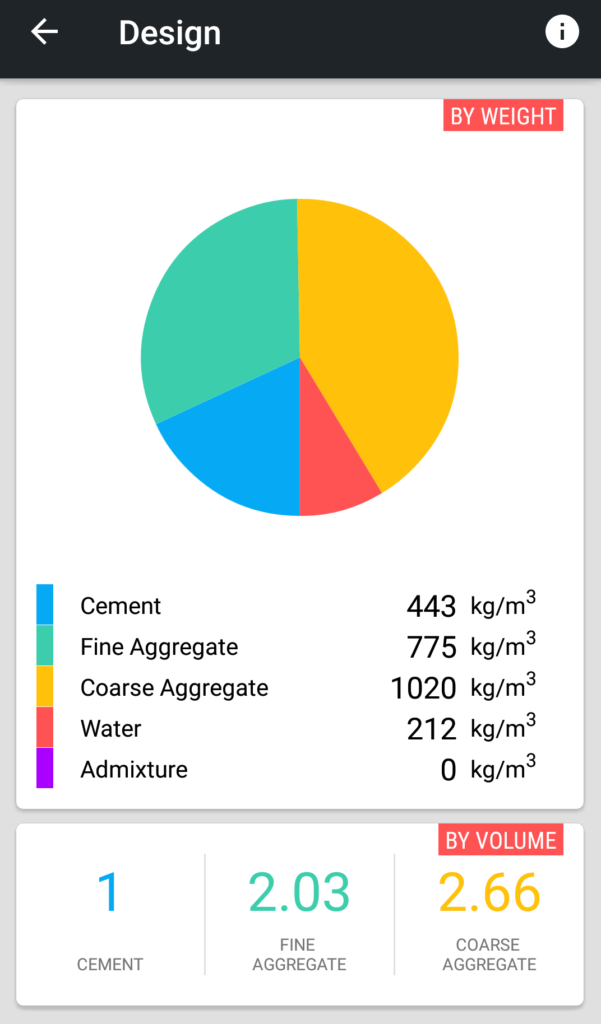
Concrete Mix Design Just In One Click
Makes You Work Easier and Fast…
In order to check the efficiency of the designed concrete mix we shall prepare different trial mixes and the same are tested to check the strength and workability of designed concrete mix. If the designed concrete mix fails to meet the desired properties then minor adjustment is done in the water cement ratio and aggregate quantities, then again the trial mixes are prepared.
Hope this post helped you to learn the step by step procedure for concrete mix design using IS code ( IS – 10262: 2009 and IS – 456: 2000)
Thank you for your Clear Details.